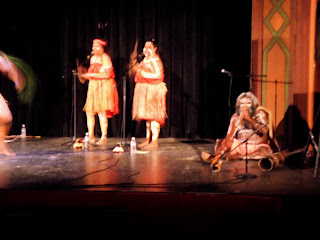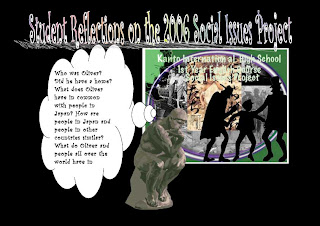I've chosen to post a few of the reflections that students in the 1st year Study Abroad Class wrote about the Social Issues Project. I think you will find reading their thoughts interesting.
Akira’s Reflection
There are four things I liked about the Social Issues Project. First, 1-Kaede was great because we were able to do the presentation without a script. I was able to enjoy to presentation because I didn’t forget what words to say. Another thing I liked was that I could study English and how many countries are doing now. Finally, I made many friends in 2-Kaede when we did peer tutoring.
I think 1-Kaede should do the Social Issues project next year. Researching foreign countries is very good. If we compare foreign countries with Japan we can get a better understanding of the world.
Connecting the book with the world todayThere are several similarities between Oliver Twist and homeless children in Australia. Oliver and homeless children in Australia suffer from physical abuse and they have no home, no money and no family. I think I’m happy because I have a home to live in, enough money and a lovely family. I want to help homeless children in the future.
Atsushi’s Reflection
There is one thing I liked about the Social Issues Project. I liked searching for information about homelessness. It was kind of hard to research about the United States but it was fun to research about that. This project was so awesome and our team did a very good job and I’m proud of my team mates.
I think 1-Kaede students should do the social Issues project next year for several reasons. One is that, this project was about a serious problem in world. I think students should learn about homelessness and be able to help homeless people. So I think this project gave us a lot of learning and made us able to make a better world for the future. We need to donate so that homeless people can stay in shelters. Also, the presentation was very fun and it was a good way to learn English speaking strategies. So I think next year students should do this project.
Connecting the book with the world today
There are lots of children who look like Oliver. Some children don’t have parents so they have to stay or sleep somewhere else on the streets.
Ryo’s Reflection
There are 2 things I liked about the Social Issues Project. First, thanks to this project I could understand about homelessness. I thought the cause of homelessness is that homeless people don’t work until I researched about this problem. Another reason is that we learned that we can present well. Every other class used scripts or notes but we didn’t. We did our best in the presentation. For these reasons, I liked the project.
I think 1 Kaede should do the Social Issues project next year for one reason. The project teaches us about the problem of homelessness. We have to understand homeless people because many people have prejudice against them. They each have a reason why they became homeless. For this reason, 1 Kaede should do this project next year.
Connecting the book with the world todayThere are several similarities between Oliver Twist and homeless children in the world. First, they don’t have a family. Second they have to work hard to live. They will die soon if they don’t work. Finally they have strong and pure hearts. For these reasons, I think they are similar.
Saki’s Reflection
There are two things liked about the Social Issues Project. First, I really liked to see each team’s beautiful poster. Second, I liked that there were presentations by all English-Course classes. I was surprised because everyone was very excited. I had a very precious experience.
Connecting the book with the world today
Finally, there are several similarities between Oliver Twist and homeless children in the world. For example, Oliver is an orphan. Many homeless children are orphans. Also, Oliver has no home, money, clothes, and so on. They are very similar, almost the same. And I think they have kindness. Homeless children work hard for their families. I think they would risk their life for their family. I really want to help such children. So, I learned many things from this project.
Shamina’s Reflection
There are 3 things I liked about the Social issues project. First of all, I liked the fact that I was able to learn about all types of social issues, whether it was about homelessness or child labor. Second, I had another opportunity to work with my classmates. Third, I had a chance to watch my friend’s presentations from other classes, which I couldn’t before. It was so much fun.
I think 1 Kaede should do the Social Issues project next year for several reasons. For one thing they can have an opportunity to learn about social issues like homelessness. Second, they can learn English and how to give presentations.
Connecting the book with the world today
There are several similarities between Oliver Twist and homeless children in Germany. For one thing, they don’t have homes. For another thing, they don’t have a family to look after them. Even if they did have one, no “family” would let a child live on the streets. Another thing, they’re poor and don’t have food to eat. These are the things I think are similar between Oliver Twist and the homeless children in Germany.




 The dance troupe also performed the dances of the Torres Strait Islanders.
The dance troupe also performed the dances of the Torres Strait Islanders.




































